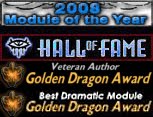Building 101 - Area Design Part 4
PART 3 RECAP
In our last entry, we took the time to define the area and broke it down based on the use of sounds and their play sequence.
We touched on avoiding random sounds playing within a defined radius due to the spike it can cause to an area.
"The main reason for this is it can cause a noticeable hiccup when the player enters the area. Each time the sound is played, the engine needs to determine from what random location within the specified Volume Distance it will fire from. It will then determine how near that sound is from the player, which then needs to determine the volume of the sound before it fires."
We also touched on the atmosphere you're going for and how good sound placement can really add to an area, so much so that at times, music is not required. Good background sound will make any area come alive when placed properly and with care.
CREATING A VISUAL ORGASM
Placeables!
"Too many will cause lag."
"Too many will ruin pathfinding."
"Too many gets my character stuck!"
Alright, we've all read about it and know that it's true. Each point is valid but it's how one goes about placing a placeable that matters.
First of all, let me discuss the first point. Lag.
In a single player module, which is my primary focus, lag exists. It's not just the stuttering one can experience but the load times. Really, it's lag because you're left waiting. That's where nice looking loadscreens come into play but that's another entry altogether.
So yes, lots and lots of placeables can cause lag but it's how you create those placeables that matter. The STATIC CHECK BOX is your friend. You do not need to have the static check box unchecked for any reason unless there is some form of animation you want the placeable to apply. This is known as the ACTIVATED selection on a placeables PROPERTIES -> ADVANCED -> INITIAL STATE option. Otherwise, leave it static.
As BioWare has also made claim to, try to avoid putting a placeable that sits on the + section of the grid. How do you go about checking this?

ENVIRONMENT -> DISPLAY GRID
I'm unable to find the original post regarding this, so if you have the message available, let me know so I can update this section.
I've read it enough times on the official Neverwinter Nights forum from many builders that it seems like a good rule to follow.
The second and third point go hand in hand.
Do your best to avoid dropping placeables in the walkable zones. Of course, it's difficult to define this but from my point of view, it's simply playing your module and walking through your created masterpiece that will allow you to determine if that tree, rock or bush is in a location that a player might take a shortcut through or happen to get stuck on while moving in a straight line.
Much of placeable design comes from edges of an area, the part of a tileset where a player simply can't walk along due to having a lack of a walkmesh to begin with.

Sadly, this does not stop a player from attempting to walk there who then becomes stuck on the placeables you've placed. In any well designed and beautiful looking area, a player will attempt to cross a boundary they were never meant to in the first place.
With 1.69, there is now a friendly placeable that can help you make sure no one can go there.
STANDARD -> MISCELLANEOUS -> INVISIBLE WALL
Create your well defined area with your placeables and follow up by adding a few of the above mentioned placeables and anyone attempting to walk there will receive the typical "NO" click sound. It's a quick and easily solution to keep players from getting stuck.
So, with some of that in mind, it's time to deliver the placeables for our area.
PLACEABLE DESIGN
With the few points that have already been mentioned, it's time to dress up the area we've been creating.
Looking back to the Area Design II entry, each corner did have an interest for the player to explore, which helps define what placeables are going to be in that specific location. The rest of the area then becomes filler for whatever catches your mood.
PART 2 RECAP
Let's recap what we had in mind for each location and follow it up with a shot of all the placeables to bring the entire area together.

1.
As already noted, we want the player to start here. During the creation of the area, we want to make sure the player is drawn to location 3, either when they first come to the area or eventually by exploring all four corners of the area. At one point or other, they'll have to cross the middle of the map.
2.
The rock fissures are small and do not stick out unless the player moves close enough to learn that information. Having two of them allows the creation of the caves and caverns below to either connect or not. Even if they do connect below, we're giving the player a choice on which side they enter from.
3.
Here is the location of our petrified villager and it's the most important location in the area for it brings truth to what the villagers were speaking about. As noted, with three of the four corners of the map exploration locations, the player is bound to find the villager before anything else. Plus, a petrified villager will stick out like a sore thumb when players hit TAB.
4.
Remember that other hill in the top right corner? This is where a boat crashed at one point, grounding itself on the hard rocky surface, cracking its hull and eventually sinking. The remains of the boat still exist but its contents are long gone.
?.
These are up in the air design choices. The question mark in the bottom right isn't a bad place for an encounter of some kind as it is out of the way and secluded but the encounter should have nothing to do with what's turning the villagers to stone.
The second question mark could be much of anything. Perhaps a small container that floated away from the broken hull of the ship or an item one of the villagers dropped while trying to flee.
FINAL DESIGN
So how does it end up looking based on the information provided?

1.
This is the arrival location of the player, who will come to this part of the swamp via a raft. So it's a wise choice to offer these visuals for the player to relate to on their journey.
A coil of rope has been added as a useable placeable, tied down to the STATIC placeable raft. When the time comes for the player to leave this area, the useable rope is their means of exit.
This exit point is always in the same location, allowing the player to know what corner they need to return to so they can move forward.
As well, we've taken the time to add placeables along the tile's edge but also taking care not to place them on the hill where the player will move their character.
2.
The rock fissures are certainly not easy to see but as the character moves to these two locations, they will enter a trigger which will fire a conversation description alerting them to a cave entrance that dives down into the earth.
Once again, a direct route is made available, placeable free, to keep the player from getting stuck while exploring these sections of the map. We also keep the majority of placeables to the very edges of the map, where the swamp is the thickest.
3.
This is the location of our petrified villager, surrounded by three pillars and two scattered swamp cypress trees. Once again, we're going out of our way to avoid massive placeables in this part of the map because it is a focal point for the player to find and thus, have to move through.
4.
The second hilly region that the player can explore offers a ruined boat tipped on its side. A few barrels and debris scatter the edge of the hill but is otherwise open for the player to explore. A conversation will fire here, offering a description of the location they've stepped into.
?.
During the creation of the area, two question marks were created due to not knowing what would go in these locations. As the rest of the area has come together, the choice here was for one question mark to be home to a set of ruins from an old cabin.
The second simply has debris and floating barrels the player can explore and possibly find some helpful items.
FINAL STEPS
Our final steps will include lighting as it too can create a wonderful experience for the player. Color that bounces off of placeables can even bring them more wonder and awe and make your vision POP!
|











